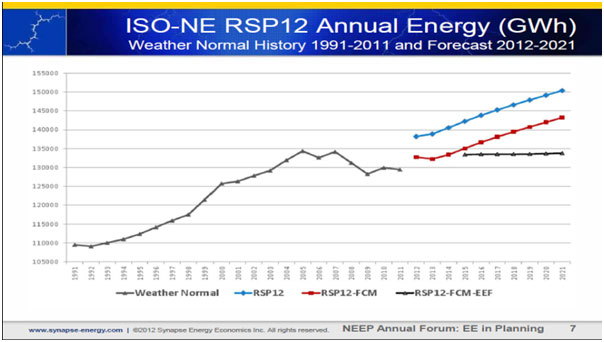
ISO-New England made headlines recently when it announced that
wholesale electric prices fell by 23% between 2011 and 2012, driven by low natural gas prices. That’s good news for consumers throughout New England, and there is more good news for the region.
ISO-New England also reported that electricity consumption dropped by 0.6% to 128,249 GWh (normalized for weather) compared with 2011. This is the second year in a row that electricity load fell in the region despite a recovering economy and represents the lowest energy consumption level since 2002.
Electricity Consumption & Economic Growth: 2002, 2006, 2009-2012
| Year |
Electricity Consumption (GWh) |
Electricity Growth Rate (%) |
U.S. Economic Growth Rate (%) |
| 2002 |
128,029 |
-- |
-- |
| 2006 |
132,087 |
-- |
-- |
| 2009 |
126838 |
-- |
-3.5% |
| 2010 |
130,773 |
3.1% |
3.0% |
| 2011 |
128,998 |
-1.4% |
1.7% |
| 2012 |
128,249 |
-0.6% |
~2.0% (est.) |
Sources: ISO-New England 2012 CELT Forecast Details, World Bank GDP Growth
We may be witnessing a long-term, downward trend in energy consumption. The U.S. Energy Information Agency
forecasts U.S. electricity consumption to grow just 0.7 percent through 2035. In our view, the Northeast’s commitment to energy efficiency has played and will continue to play an important role in keeping electricity consumption flat even with more robust levels of economic growth. ISO-New England’s most recent energy efficiency forecast, for example, shows that state energy efficiency programs will help keep electricity load flat at pre-recession levels through 2021.
That portends a major shift in electricity consumption in New England. NEEP forecasted that robust energy efficiency programs could head off all load growth originally predicted as far back as 2005. While natural gas prices can help keep rates low, energy efficiency and demand side management can help reduce bills now and in the future by avoiding the need for new transmission and generation. States are reaping the benefits of their “big bet” on energy efficiency a few years ago and it’s important that we work to get to word out.
 Source: Paul Peterson, Synapse Economics, December 2012
Source: Paul Peterson, Synapse Economics, December 2012